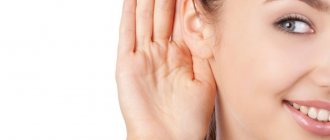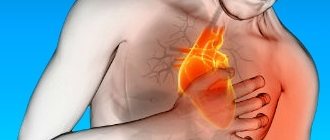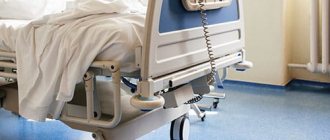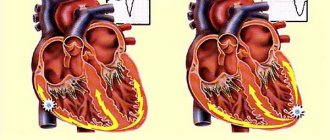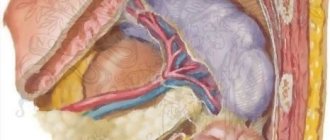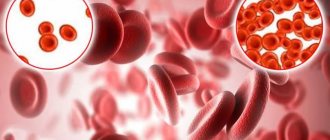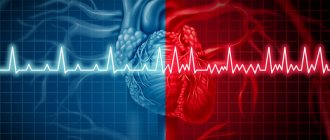Somersaulting heart - what kind of pathology is this?
Extrasystole is a pathological process in which a change in the normal myocardial rhythm is observed. The pathology is accompanied by extraordinary contractions of an intense nature, both of the entire human organ and of the individual ventricles.
As the disease develops, the release of blood from the myocardium decreases. The process leads to a decrease in coronary blood flow and in the veins supplying the brain.
This condition provokes the formation of angina pectoris, the occurrence of frequent cardiac fainting and paresis. The result of the pathology is the acquisition of atrial fibrillation by a person, as well as the possibility of sudden death.
Doctors say that pain and discomfort in the chest occurs in most people. Isolated manifestations are observed even among young people. In people who have crossed the 50-year mark, pathology is recorded in 65-80% of cases.
Diagnostics
The easiest way to identify the disease is with an electrocardiogram. This type of study guarantees an accurate and easy calculation of the malfunction of the heart muscle, because all abnormal, normal and rapid contractions appear on the tape.
However, it is not always possible to detect extrasystoles using a cardiogram, because the procedure for obtaining a “snapshot of the heart’s work” lasts a short time and it is during this period that the heart can work like a clock. All this is due to the fact that during the ECG the patient is in a supine position, i.e. does not show activity, but in life the person is usually active.
If extrasystole cannot be detected by this method, the patient is prescribed a Holter mount. This method involves monitoring the patient throughout the day, which should take place in his usual way. It is in this way that the doctor will be able to determine the absence or presence of disruptions in the rhythm of muscle work.
Causes of heart tumbling
Somersault of the heart varies depending on the cause of its occurrence. There are organic and functional extrasystole. In the latter case, the abnormal behavior of the myocardium does not arise due to problems with the main organ. The cause of the behavior of the heart muscle is a malfunction in the functioning of the nervous system. Factors that provoke fluttering in the gridy are due to the following:
- lack of vitamins in the body;
- Excessive consumption of alcohol and tobacco products;
- A person's prolonged stay in a stressful situation;
- Effects of large amounts of caffeine on internal organs;
- Hormonal imbalance in women.
The first type of extrasystole is organic. It develops only during a pathological process in the heart muscle. The following diseases can provoke a feeling of tumbling of the main human organ:
- Heart attack;
- Long-term circulatory failure, recorded as chronic;
- Cardiosclerosis;
- Developmental defect;
- Ischemic myocardial disease;
- Cardiomyopathy;
- Pericarditis;
- Hemachromatosis;
- Sarcoidosis.
Pathology can also develop after surgical interventions on the heart muscle. In people involved in sports, the feeling of the heart tumbling is caused by dystrophy of the main organ. This process occurs due to excessive physical exertion.
Arrhythmia: symptoms and treatment
The article was prepared by cardiologist Ksenia Nshanovna Borel
Arrhythmia... Perhaps the interpretation “I am worried about arrhythmia” is one of the most common complaints of cardiac patients of any age.
In fact, there is no diagnosis of arrhythmia. There is a specific disturbance in the rhythm and/or conduction of the heart, which must be recognized in time by the attending physician in order to take measures to eliminate it, if required.
I will not tire of singing the praises of my heart: this is a unique organ not only in terms of the functions it performs, but also in terms of its structural features. Did you know that the heart muscle (myocardium) is very unusual? It does not simply contract mechanically, like any other muscle in the human body.
Deep in the myocardium there are special cells of the conduction system that are capable of generating nerve charges, converting an electrical impulse into a mechanical muscle contraction:
- The main conductor of this complex composition is the sinus node (also known as the first order pacemaker), located in the wall of the right atrium. It is the power plant that reproduces charges at a frequency of 60-90 per minute, which is the normal (in terms of frequency and regularity) heart rhythm. Next, nerve impulses are transmitted to the underlying sections.
- From the sinus node, the nerve impulse runs along three highways to the atrioventricular node. It is a kind of gateway with selective throughput and provides a physiological delay in the conduction of charges formed in the sinus node. The atrioventricular node is capable of generating nerve impulses with a frequency of 40-60 per minute (this is a second order pacemaker).
- This is followed by the His bundle (third order pacemaker) with the right and left legs, which generate nerve impulses with a frequency of 20-40 per minute.
- Well, the most extreme branches of the conduction system of the heart are Purkinje fibers, operating at a frequency of 15-20 impulses per minute.
A peculiarity of the conduction system of the heart is that its normal operation is regulated by the sinus node: nerve impulses “born” in it spread from top to bottom, occupying all conduction tracts, leaving no chance for other pacemakers to generate their own nerve impulses, suppressing their activity . Thus, if a patient develops arrhythmia, it means that either the formation of a nerve impulse in the sinus node is disrupted, or so-called ectopic (not from the conduction system) foci of nerve impulse formation appear, or the conduction of a nerve impulse in various parts of the conduction system is disrupted (aka blockades) .
How does a patient suffering from rhythm disturbances feel?
Very often we hear various metaphors from patients when describing their condition when they feel an arrhythmia. They often say that the heart “gurgles”, “turns over”, “quivers”, “freezes”, “shakes like jellied meat”, “beats like a bird in a cage”, “pounds” and many others. Remember the words from the song of the group “Spleen”? “My heart stopped, my heart froze...” Sasha Vasiliev sang about arrhythmia.
In a conversation with the patient, it is very important to find out several factors that will help to predict the nature of the arrhythmia and determine its potential danger to life. So, if you are worried about arrhythmia, try to characterize it using the following parameters:
- What causes arrhythmia? What is the cause of arrhythmia?
- Does the arrhythmia begin paroxysmally or gradually, with a “warm-up” period?
- What is the heart rate for arrhythmia?
- How long does the arrhythmia last?
- During an arrhythmia, do you feel pain in the heart area, shortness of breath, dizziness, or decreased blood pressure? Or maybe you even develop a fainting state or briefly lose consciousness?
- Does the arrhythmia stop spontaneously? Or does it stop only after using certain medications or when performing specific manipulations?
- How often does arrhythmia bother you? Is there a frequency of its repetition?
As you already understand, arrhythmias can be classified into paroxysmal (non-paroxysmal and paroxysmal) and constant. In addition, arrhythmias can be with an increase (more than 90 per minute) or a decrease (less than 60 per minute) of the heart rate.
We must not forget that changes in heart rhythm can be normal. For example, sinus tachycardia in response to emotional experiences or physical activity. And, conversely, sinus bradycardia during sleep under the influence of the vagus nerve or in professional athletes. In addition, the presence of up to 20 extrasystoles per hour is not considered a pathology when performing daily ECG monitoring.
What are the causes of arrhythmias?
The reasons are varied, but they can be standardized into 2 large groups, which often determine the patient’s management tactics: a distinction is made between organic (associated with anatomical defects in the structure of the heart and blood vessels) and functional (due to changes in the tone of the autonomic nervous system).
Among the organic causes, the main ones are coronary heart disease and previous myocardial infarction, cardiomyopathy, previous myocarditis, heart failure with low ejection fraction, left ventricular hypertrophy (due to hypertension or valve defects). Functional arrhythmias are more common in young patients and usually manifest as sinus tachycardia or sinus (respiratory) arrhythmia.
In addition, it is important to separately identify the so-called channelopathies, or electrical heart diseases, which, as a rule, are congenital pathologies in which the normal content of ions and electrolytes changes at the biochemical level.
There are a huge number of types of arrhythmias. Despite this, they are quite easy to diagnose. You just need to register an ECG. As a rule, major difficulties may arise here: it is not always possible to record an ECG at the moment when the patient feels an arrhythmia.
It often happens that the ECG outside an attack of arrhythmia is absolutely normal and uninformative for diagnosing the nature of the heart rhythm disturbance. I always recommend to my patients to call an ambulance or go to the nearest medical facility where they could record an ECG while the patient is experiencing arrhythmic sensations.
But it also happens that the arrhythmia persists for a very short time, or the heart rhythm returns to normal before the ambulance arrives. In such situations, it is necessary to recommend that the patient perform Holter (24-hour) ECG monitoring, in which the heart rhythm is recorded throughout the day. But even here there can be a catch: in the absence of daily frequency of arrhythmia, monitoring may be uninformative. Then it is necessary to carry out transesophageal pacing to actively provoke arrhythmia.
Treatment of arrhythmia directly depends on its nature and the reasons that caused it.
- For organic arrhythmias, treatment of the underlying disease is necessary. For example, in patients with a history of myocardial infarction, the appearance of ventricular extrasystoles is an unfavorable sign and may be associated with atherosclerosis of the coronary arteries.
- For functional arrhythmias, normalization of the work and rest regime is sufficient.
- For arrhythmias with a low pulse rate, which are accompanied by poor health (weakness, shortness of breath, lightheadedness, dizziness, loss of consciousness), implantation of a pacemaker is indicated.
- For arrhythmias with a high pulse rate, the prescription of tableted antiarrhythmic drugs or, if they are ineffective, radiofrequency ablation (laser cauterization) of the heart rhythm disturbance is indicated.
- If the arrhythmia is life-threatening, then patients are advised to undergo implantation of a cardioverter defibrillator.
- For some arrhythmias, so-called vagal tests are effective: holding your breath with straining at the height of inspiration for 5-10 seconds, reproducing the gag reflex by pressing on the root of the tongue with your fingers, immersing your face in a basin of ice water (“diving reflex”). But these tests are not a way to treat arrhythmias, but more often serve as assistants in their diagnosis.
The topic of arrhythmia is quite extensive. In each specific case, the approach is very individual. The patient’s task is to consult a cardiologist in a timely manner.
Take care of your health, and then the melody of your heart will always be rhythmic.
MAKE AN APPOINTMENT WITH A CARDIOLOGIST
Clinical picture of the disease
The functional manifestation of extrasystole does not cause concern. Organic tumbling of the heart muscle is considered dangerous. The patient most often complains of intense shocks from inside the chest, turning over of the myocardium in its place, as well as interruptions in the functioning of the main human organ - its periodic freezing.
Only the attending physician can identify the presenting symptoms:
- Increased activity of the sebaceous glands, causing excessive sweating;
- Oxygen starvation of internal organs;
- The occurrence of anxiety of an unreasonable type;
- Severe headaches of an intense nature;
- Frequent dizziness and periodic fainting;
- Manifestation of shortness of breath in a calm state and hot flashes throughout the body.
If any of the symptoms appear, it is recommended to consult a doctor immediately. When diagnosing, a cardiologist will identify the cause of the development of the pathological process and prescribe effective treatment.
When a pathology is detected, it is worth monitoring your own body. Most often, the process occurs imperceptibly to humans. But in some situations, if the heart turns over more than 5 times in 1 minute, this is a cause for concern.
Extrasystole - what is it?
This is a representative of the most common heart diseases. The term reflects heart rhythm disturbances when contraction occurs much earlier than that of a healthy muscle. This disease is easy to identify; if there are complaints about the heart tumbling, the patient is sent to an ECG, which shows a premature or rapid rhythm.
Ideally, such a heart problem can be detected even in a healthy person, which means that such a disorder does not require emergency treatment. However, there is a certain norm when the number of extrasystoles is not life-threatening - no more than 200. If it is less, then there is nothing to worry about, and the person is absolutely healthy, because like any other organ, the heart cannot work 100% perfectly.
When a person experiences extrasystole more often and notices some symptoms of tachycardia, this is a reason for an early examination by a doctor. Because behind these symptoms there may be more serious ones that can lead to irreversible consequences.
It is necessary to combat extrasystole in the following cases:
- hemodynamic disorders caused by nervous heart rhythm;
- personal feelings of a person when he realizes that the frequency and evenness of the heartbeat is no longer the same and begins to cause discomfort;
- if during the examination the doctor detects a deterioration in myocardial performance, which in no case should be left without medical intervention.
Treatment of heart beats
If sharp tremors in the heart area are caused by a lack of potassium and sodium, the doctor adjusts the diet, recommends taking vitamin complexes, and saline-based injections. The specialist calculates the amount of salt and prescribes a course of therapy with Narzan mineral water. In case of incomplete absorption of nutrients, an examination of the digestive system and consultation with a gastroenterologist is required.
The presence of psychogenic factors must be treated using different methods:
- Eliminate bad habits, stop smoking and drinking alcohol.
- Take natural herbs to relieve tension, stress, and improve sleep. Instead of tea and coffee, you can drink a decoction of motherwort, mint, chamomile, or peony infusion.
- For frequent attacks of extrasystole (more than 200 beats per day), it is necessary to select sedative medications to normalize the functioning of the nervous system: Persen, Sedofyton, Novo-Passit.
Often the cause of tremors is cervical osteochondrosis. His treatment is carried out by a neurologist together with a cardiologist. The therapeutic course includes therapeutic massage, physiotherapy, taking anti-inflammatory drugs: Movalis, Diclofenac, Nimesulide. Muscle relaxants help relieve tension and reduce discomfort in the heart area: Mydocalm, Sirdalud, Tizalud.
Prevention of tremors in the heart is to prevent diseases that can disrupt its functioning: colds, flu, sore throat, internal infections. Moderate cardio exercises are recommended, which strengthen the heart muscle well and stimulate its stable functioning. Proper nutrition and a nutritious diet maintain electrolyte balance and prevent complications due to stress.
Why is it dangerous?
Any kind of signs of a disease of the cardiovascular system seriously worries a person, since illnesses associated with it pose a serious threat to life. In fact, in some cases, extrasystole is completely harmless and safe for health, and does not pose any threat to life and normal functioning.
Frequent observations of tumbling, heart movement in the presence of problems with the system or muscle should be the reason for an immediate visit to the doctor. If you have persistent high blood pressure, a heart attack, or other similar problems, even minor pain or similar symptoms can signal an extremely life-threatening situation.
To find out whether the phenomenon is serious or caused by certain factors, it is enough to carefully monitor your own lifestyle. To find out the situation, they give up bad habits, get enough rest and don’t overload themselves with work, try to stay calm and protect themselves from stress by following a proper diet. If the extrasystole is not associated with diseases of the heart muscle, it should go away as a result of a correct lifestyle.
